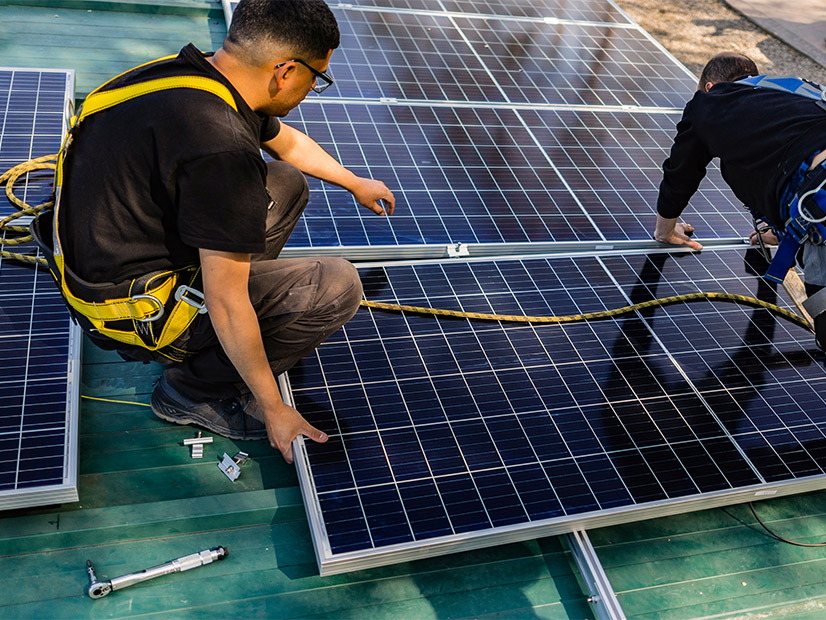The Maryland Energy Administration (MEA) has $22.5 million it’s planning to use to make low-income homes more energy efficient and put solar panels on their roofs. It just wants to make sure none of the money is spent on new appliances or systems powered by fossil fuels.
The MEA, along with Gov. Wes Moore (D), announced Dec. 11 the money will be available through two long-standing programs — the Energy Efficiency Equity (EEE) Grant Program and the Solar Energy Equity (SEE) Grant Program — but with some new requirements and opportunities for 2024.
EEE will offer $19.5 million for energy-efficiency upgrades that “generate significant reductions in energy use and pass on the benefits of the savings” to Maryland’s low- and moderate-income residents, according to the MEA website.
But in a significant shift, the program will prioritize “electrification and zero-emissions technologies,” according to the funding announcement.
“Therefore, beginning in [fiscal 2024], the replacement of existing fossil fuel equipment (e.g., HVAC, water heater) with new fossil fuel equipment is ineligible for funding via the program, even if the proposed new equipment has a higher efficiency rating.”
Upgrades to existing fossil fuel equipment will be funded provided they increase system efficiency, the announcement says.
Extra funding also will be available to pay for additional upgrades that support electrification, such as the installation of new electrical panels or circuits.
The application deadline is Feb. 16.
The Solar Energy Equity (SEE) Grant Program will have $3 million to pay the full cost — up to $25,000 — of installing solar panels on the roofs of homeowners in LMI or “overburdened” communities, which are defined as areas that historically have suffered from high levels of air or water pollution or other environmental impacts.
To qualify for the program, a household already must have participated in a state-funded weatherization or energy efficiency program, such as EEE. Up to $5,000 of a $25,000 grant can be used for roof repairs or mold remediation.
The program also allows homeowners to choose either owning the rooftop panels outright or enrolling in a leasing program in which state funds are used to pay off a 20-year leasing contract so the homeowner has no further payments on the system.
Households that go for an ownership option will be allowed to sell the solar renewable energy credits (SRECs) generated by the system, with the proceeds to be used for system maintenance and insurance.
Solar owners earn one SREC for every 1,000 kWh of power their panels produce; the current value of an SREC in Maryland is about $52 to $56, according to the Flett Exchange, an online platform for SREC sales.
The application deadline for the SEE program is Feb. 22.
MEA Administrator Paul Pinsky framed the programs as an integral part of the state’s march toward a 60% reduction in greenhouse gas emissions from 2006 levels by 2031, a target set in the Climate Solutions Now Act (CSNA) of 2022, and Moore’s goal of a 100% clean energy grid by 2035.
Pathways to Electrification
Both Moore and Pinsky stressed that the funding for the two programs is aimed at ensuring an equitable energy transition in which no communities or households are left behind.
The funding for both programs will go through nonprofits or local governments but is set up to reach a range of communities. For the EEE program, Maryland is divided into five regions, each of which is allocated a certain amount of the $19.5 million, based on population, with a 25% carveout for funding to groups that previously have not been awarded grants from the program.
For example, the Western region of the state — including Frederick, Washington, Allegany and Garrett counties — has been allocated just under $1.9 million, with $484,203 earmarked for first-time applicants.
The EEE ban on new appliances powered by fossil fuels appears to be a careful step toward reducing natural gas use in Maryland, in the absence of direct state-level legislative action on the issue. In November 2022, Montgomery County, Maryland’s most populous county, passed a law requiring the electrification of all new residential and commercial construction, with exemptions for certain businesses, such as restaurants. The new rules are scheduled to go into effect by the end of 2026. (See Montgomery County, Md. Passes Building Electrification Law.)
The CSNA also required the Maryland Department of the Environment to develop building performance standards for commercial buildings of 35,000 square feet or more, with the goal of cutting GHG emissions from these buildings 20% below 2025 levels by 2030 and reaching net zero by 2040.
The proposed regulations are scheduled to be released Dec. 15.




